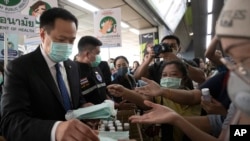Singapore was hit a month ago with a surge in novel coronavirus cases that originated in China but capped the spread. Malaysia and Thailand watched beach tourists drain away as Chinese were required to avoid travel. Factory slowdowns in China caused by workers staying home to dodge the disease cut demand for Indonesian commodities.
Nevertheless, analysts in Southeast Asia expect the region of 654 million to weather this outbreak. The outcome matters because the flow of tourists, capital and raw materials into Southeast Asia is more contingent on China than is the case elsewhere.
Vietnam and the Philippines expect more capital from foreign investors fatigued by risks in China, for example. Southeast Asian governments are cutting interest rates and approving economic stimulus for companies shaken by loss of business. The 10-member Association of Southeast Asian Nations is working toward a massive trade liberalization deal with China and Japan to stoke commerce.
“Obviously there’s going to be impact, but again we have the China-plus-one here,” said Ralf Matthaes, founder of the Infocus Mekong Research consultancy in Ho Chi Minh City, Vietnam, referring to investors with plants in China hoping to diversify into a second country.
“There’s lots of people who are moving their factories here, so I think all [the coronavirus] does is emphasize that you’ve got to further decentralize your manufacturing bases,” Matthaes said.
Southeast Asian manufacturers may diversify sources of supply, too, said Tham Siew Yean, professor emeritus at Universiti Kebangsaan Malaysia. “But this will impact costs since alternative sources, where available are more expensive,” she said.
Several Southeast Asian countries hope interest rate cuts will stimulate corporate lending.
Indonesia, a coal, gas and rubber supplier, dropped rates to 4.75% last month against the risk of falling commodity prices. Chinese manufacturers usually buy those raw materials but orders slowed when many workers stayed home last month after the Lunar New Year.
Thailand lowered its rate to 1% last month because of its “large exposure” to Chinese tourism and reliance on Chinese auto manufacturing, Moody’s Analytics said in a February 26 research note. Malaysia could cut rates as well as consumer demand falls, the note says.
Singapore has reported the region’s biggest single-country outbreak, 98 cases, but media reports credit the city-state for getting its caseload contained. Singapore also raised government spending by 7%, despite a budget deficit, across two relief packages totaling $4 billion.
Malaysia and Indonesia came out with their own stimulus packages to combat impacts from the disease officially called Covid-19.
The Philippine economy will probably grow at least 6% this year because of rate cuts and infrastructure spending due to last through 2022, said Jonathan Ravelas, chief market strategist with Banco de Oro UniBank. The Asian Development Bank had forecast last year that the archipelago’s GDP would rise 6.2%.
New roads, airports and power generation projects, worth $180 billion, are expected to make the Philippines more attractive to manufacturers.
“If we play our cards right by doing more infrastructure spending and hasten the pace, we can still grow at 6%,” Ravelas said.
Responses such as these preceded a meeting Monday among senior ASEAN officials. Their economic ministers had been scheduled to meet this month in Las Vegas, but has been postponed.
ASEAN said last year that it would sign the Regional Comprehensive Economic Partnership with Australia, China, Japan, New Zealand, South Korea and possibly India at this year's session. The deal would cut tariffs, a boon to exporters.
“This will widen integration and as one of the largest international grouping it will provide a strong signal for the support of international trade despite the negative impact on trade from the COVID.” Tham said.








